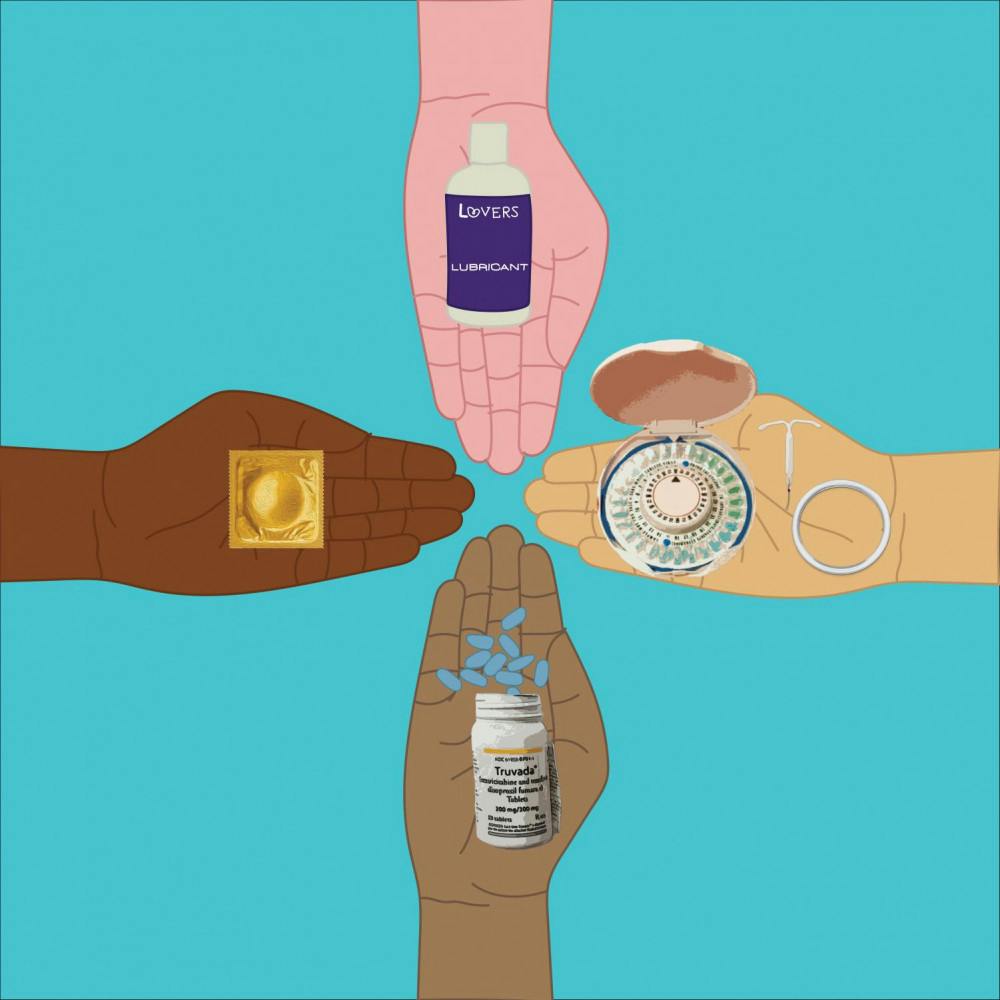Well over half -- 65% -- of Americans have their first sexual encounter by the age of 18, according to reproductive rights group Guttmacher Institute. But in a country where high school sexual education classes usually fail to include key issues such as consent, contraception, general sexual wellness and the spectrum of gender and sexuality, many of those young people’s sexual experiences are confusing, unhealthy or even dangerous.
I asked Mercer students on social media what they wish they learned about sexual health earlier or what they still don’t know to clear up some of the confusion that our sex-ed classes may have left us with. Here are your questions, answered.
What is lubricant? Should I use it?
Lubricant can be made from oil, water or silicone. The different types come with different pros and cons, according to Healthline, but they’re all considered safe to use. (Just beware: while lube can and should be used with condoms, oil-based types increase the risk of ripping.)
A major benefit of lube for people with vaginas is its ability to mitigate vaginal dryness. Vaginas are typically self-lubricating, but anything from stress to hormones to menstruation can cause dryness. Dryness can increase friction, cause pain and lead to vaginal tearing, which can increase risks for sexually transmitted infections. Applying lube to a penis or sex toy prior to penetration can make sex safer and more pleasurable for those experiencing dryness.
But that’s far from its only use: in an Indiana University study in 2009, 70% of folks with vaginas reported that lube just made sex more pleasurable, whether they experienced dryness of not. Some types of lubricant that are formulated to prompt different sensations that can be exciting for both the receiving or giving partners, and lube may prolong the amount of time someone with a penis can engage in sex. So if you’re into any of that, lube away!
While lube is fairly optional for P-in-V sex, health experts recommend it unequivocally for all anal sex. The anus does not self-lubricate, so penetration by a penis or sex toy can cause pain or even damage the sensitive tissues there. Definitely use plenty of lube for anal play.
What is douching, and is it safe?
Douching is the practice of “washing” out one’s vagina using a store-bought product. Typically, a douche comes in a bottle and is sprayed into the vagina. However, according to WebMD, there is no scientific evidence that douching provides any benefit, but there is plenty of data indicating that it’s unsafe. The American College of Obstetricians and Gynecologists also warns against it.
Douching increases your risk of contracting vaginal infections as well as pelvic inflammatory disease, which “is an infection of the uterus, fallopian tubes, and/or ovaries,” according to WedMD. Douching may increase your risk of contracting PID by 73%. It’s also been linked to difficulty conceiving, heightened risk of ectopic pregnancy and heightened risk of cervical cancer.
Vaginas are self-cleaning, according to the U.S. Department of Health & Human Services’ Office on Women’s Health. They clean themselves by making mucus, which washes away blood, semen and discharge (more on discharge in a second), so douching is unnecessary as well as harmful.
Remember, the vagina is the canal inside of the body; the vulva is outside of the body and should be cleaned with warm water and unscented soap. The vagina will take care of itself!
Is vaginal discharge normal?
In a word: yes. It’s super common and can be influenced by your menstrual cycle, your hormones and other factors. It’s different from arousal fluid, which the vagina can produce during sexual activity. Consistency, color and smell can vary, but as long as nothing seems different than it usually has been for your body, you should be good to go, according to Clue.
However, Clue says that changes in consistency, color, volume and smell may indicate yeast infections, bacterial vaginosis or trichomoniasis. Douching, hormonal birth control, irregular bleeding patterns, some medicines, hormonal changes, diabetes and other environmental factors can also contribute to the disruption of your vaginal PH and microbial makeup.
If anything has changed in your sexual health or activity and you start to notice some changes in discharge, that’s a sign to talk to a healthcare provider, but discharge itself is normal and nothing to worry about.
How often should I be tested for sexually-transmitted infections?
The answer to this question varies depending on lots of factors: your age, your sex, your sexual orientation, the frequency with which you have sex and more. But the standard guidance from the Mayo Clinic is to get tested for chlamydia and gonorrhea annually if:
- you’re a heterosexual, cisgender woman under 25 who is sexually active
- you’re a heterosexual, cisgender woman over 25 who is having sex with a new partner or multiple partners
- you have a penis and have sex with other people who have penises
- you have HIV
Guidance changes for other STIs. When it comes to HIV, syphilis and hepatitis, The Centers for Disease Control and Prevention suggests the following:
- HIV test at least once between the ages of 13-64, or yearly if you belong to a group with increased risk
- hepatitis tests if you haven't been vaccinated (but if you born after 1965, you very likely were)
- tests for all three if you have tested positive for another STI
- tests for all three if you have had more than one partner since your last test or used IV drugs
- tests for all three if you used intravenous drugs
- tests for all three if you have a penis and have sex with other people with penises
- tests for all three if you are planning to become pregnant or are pregnant
You should also get tested if you’ve been subjected to non-consensual sexual activity.
Tests for genital herpes and human papillomavirus (HPV) aren’t super reliable, Mayo Clinic says. If you have a vagina, you should get a Pap test every three years between the ages of 21-65, which can indicate the presence of HPV to a doctor.
It’s important to get tested for STIs because you may have them without displaying symptoms, meaning you may spread them to partners without knowing, according to Men’s Health. But you shouldn’t feel ashamed if you end up testing positive, and you shouldn’t be afraid that you can’t have a “normal” love life and sex life. Just talk to your doctor and consult other resources they recommend for taking care of yourself and disclosing your status to a partner or partners, and it’ll be okay.
What types of contraceptives are available, and how do I know if I should use one?
Birth control, birth control -- there are plenty of types with plenty of effects and, yes, plenty of side effects. You may not want to use birth control for personal, religious or health reasons. You may not know which type you are comfortable with. That’s okay! There is no one-size-fits-all contraceptive, and you might want to try some trial and error to find one that works for you. You may ultimately decide that there isn’t one that you like, and that’s perfectly fine, too. You may prefer a natural method such as fertility tracking.
Here’s a quick rundown of common medical birth control options:
Condoms: Condoms are latex or plastic pouches that go over a penis or shared sex toy to prevent pregnancy and STIs by blocking contact with semen and vaginal fluids. They are inexpensive, ubiquitous and, when used properly, incredibly effective. They should be used every time a person has vaginal or anal sex with a new partner, especially if either partner’s STI status is positive or unknown. They can also be used during oral sex involving penises. People with uteruses who do not wish to become pregnant should also use them every time they have sex with someone who has a penis.
You can also choose an internal condom, which can be placed inside the vagina or anus to create a barrier. They are just as effective as external condoms at preventing STIs and pregnancy, but slightly more likely to be used improperly, according to Planned Parenthood. For oral sex involving anuses or vaginas, dental dams -- a type of condom -- can be effective.
Implant: If you have a uterus and vagina, you may opt for an implant. This matchstick-sized rod is inserted under the skin of your upper arm and can remain there for three years. It is considered one of the most effective types of birth control but cannot protect against STIs, so it is recommended that you also use a barrier method (i.e. condom) during partnered sex.
IUD: An IUD, or intrauterine device, is a tiny T-shaped device inserted into a person’s uterus. There is a copper type and a type that releases hormones to prevent pregnancy. Like the implant, it is long-lasting (five to 12 years depending on the brand) but can be removed at any time. It does not prevent STIs. It can also be used as emergency contraception.
Shots: People with uteruses can also get birth control shots to prevent pregnancy. Shots are required every three months. The shot is slightly less effective than the implant and IUD because it can be difficult to stick to the precise schedule. Shots cannot prevent STIs.
Rings and patches: Rings and patches are equally effective at preventing pregnancy, slightly less so than the shot, and must also be maintained on a schedule. Rings are inserted into the vagina, where they release pregnancy-blocking hormones that are absorbed through the vaginal lining. Patches are worn externally, where they release pregnancy-blocking hormones that are absorbed through the skin. Neither can prevent STIs.
Pills: Pills are the most common birth control method. Taken daily, they release hormones into the body that prevent pregnancy. They do not prevent STIs and are considered just as effective as rings and patches at preventing pregnancy.
This is far from an exhaustive list of contraception options, but they are the most common and generally the most accessible choices. All are associated with some side effects, but the exact effects and their severity varies hugely by type, brand and your individual body. Be sure to talk to a doctor about side effects, natural methods or less common birth control options if you’re interested in contraceptives.
What do LGBTQIA+ partners need to know?
This question was one of the most common ones that I received. It makes sense: sex ed is lacking for all genders and sexualities in schools, but LGBTQIA+ sex ed is nearly non-existent.
The truth is that this question isn’t something I can answer as asked. LGBTQIA+ sexual education is extremely broad because the spectrum of queerness itself is so wide; sexual health looks totally different for people in the community according to their sex assigned at birth, their gender expression, their sexual orientation, their personal preferences, their medical history and more.
This article offers a wonderfully thorough jumping-off point for people on the queer spectrum, and the CDC maintains a list of resources for all bodies and identities. Queer folks may need to be tested for STIs more frequently, may face barriers to accessing sexual health care, may not be informed on how gender-affirming treatments affect their reproductive systems or may be uncertain whether to use contraceptives for certain sexual acts, so be sure to find the information that’s most relevant to you.





